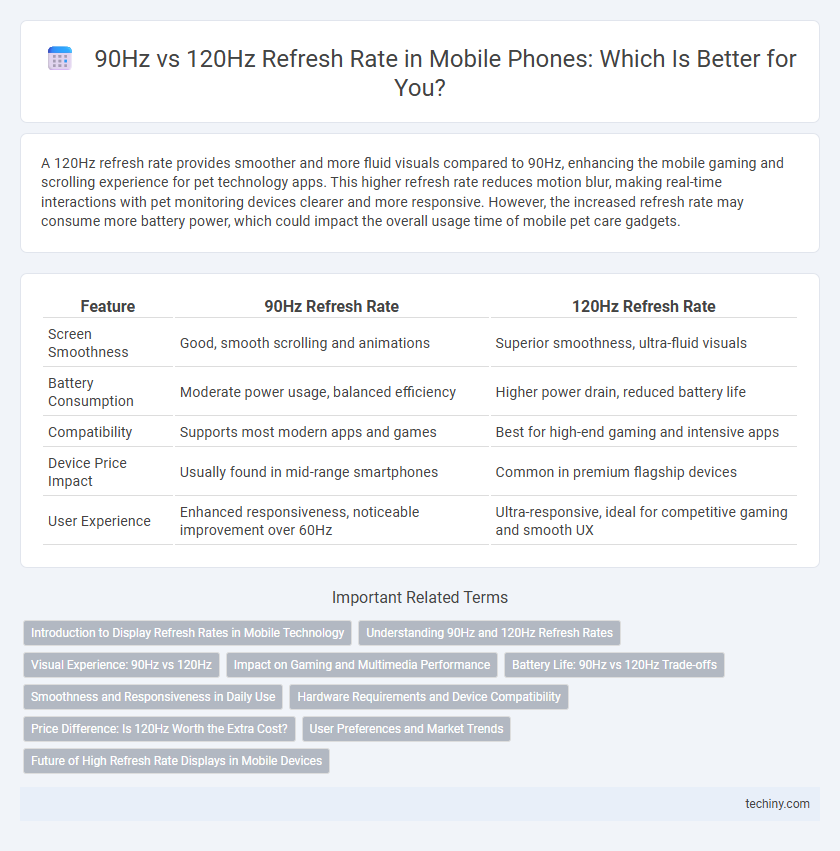A 120Hz refresh rate provides smoother and more fluid visuals compared to 90Hz, enhancing the mobile gaming and scrolling experience for pet technology apps. This higher refresh rate reduces motion blur, making real-time interactions with pet monitoring devices clearer and more responsive. However, the increased refresh rate may consume more battery power, which could impact the overall usage time of mobile pet care gadgets.
Table of Comparison
| Feature | 90Hz Refresh Rate | 120Hz Refresh Rate |
|---|---|---|
| Screen Smoothness | Good, smooth scrolling and animations | Superior smoothness, ultra-fluid visuals |
| Battery Consumption | Moderate power usage, balanced efficiency | Higher power drain, reduced battery life |
| Compatibility | Supports most modern apps and games | Best for high-end gaming and intensive apps |
| Device Price Impact | Usually found in mid-range smartphones | Common in premium flagship devices |
| User Experience | Enhanced responsiveness, noticeable improvement over 60Hz | Ultra-responsive, ideal for competitive gaming and smooth UX |
Introduction to Display Refresh Rates in Mobile Technology
Display refresh rate in mobile technology defines how many times per second the screen updates its image, measured in hertz (Hz). A 90Hz refresh rate offers smoother visuals compared to the standard 60Hz, enhancing user experience in animations and scrolling. Moving to 120Hz further elevates fluidity and responsiveness, ideal for high-performance gaming and fast-paced content.
Understanding 90Hz and 120Hz Refresh Rates
90Hz and 120Hz refresh rates refer to how many times per second a mobile device's screen updates its display, with 90Hz refreshing 90 times per second and 120Hz 120 times per second. A higher refresh rate like 120Hz results in smoother animations, more fluid scrolling, and a more responsive gaming experience compared to 90Hz, although it may consume more battery power. Many flagship smartphones now support 120Hz displays to enhance visual performance and user interaction, especially in fast-paced applications and games.
Visual Experience: 90Hz vs 120Hz
A 120Hz refresh rate delivers smoother animations and more fluid scrolling compared to 90Hz, enhancing overall visual responsiveness in mobile devices. The higher refresh rate reduces motion blur and improves the clarity of fast-moving content, which is especially noticeable in gaming and video playback. While 90Hz already provides a significant upgrade from the standard 60Hz, the jump to 120Hz offers a noticeably more immersive and seamless visual experience.
Impact on Gaming and Multimedia Performance
A 120Hz refresh rate offers smoother motion rendering compared to 90Hz, significantly enhancing gaming responsiveness and visual fluidity in fast-paced titles. Higher refresh rates reduce motion blur and input lag, providing a more immersive multimedia experience with sharper video playback and seamless animations. While 120Hz delivers superior performance, it also demands more from the GPU and battery, requiring devices with optimized hardware for sustained high refresh rate benefits.
Battery Life: 90Hz vs 120Hz Trade-offs
A 90Hz refresh rate consumes noticeably less battery than a 120Hz refresh rate, extending device usage between charges. The higher 120Hz refresh rate offers smoother animations and improved responsiveness but results in increased power consumption due to more frequent screen updates. Users prioritizing battery longevity often prefer 90Hz for a balanced experience between performance and energy efficiency.
Smoothness and Responsiveness in Daily Use
A 120Hz refresh rate delivers smoother animations and more fluid scrolling compared to 90Hz, enhancing responsiveness in gaming and app navigation. The higher frame rate reduces motion blur and input lag, resulting in a noticeably more seamless user experience during fast-paced interactions. While both refresh rates improve over the standard 60Hz, 120Hz provides superior smoothness that benefits multitasking and visually intensive tasks on mobile devices.
Hardware Requirements and Device Compatibility
A 120Hz refresh rate demands more advanced hardware, including a more powerful GPU and a higher-capacity battery, to maintain smooth performance without compromising battery life, compared to 90Hz displays. Devices with mid-range processors and standard OLED or LCD panels often support 90Hz, while 120Hz is typically found in flagship smartphones equipped with high-end processors like the Snapdragon 8 series or Apple's A-series chipsets. Compatibility issues arise as not all apps and games are optimized for 120Hz, causing inconsistent frame rates and possible screen tearing on devices that attempt to push higher refresh rates without adequate hardware support.
Price Difference: Is 120Hz Worth the Extra Cost?
A 120Hz refresh rate offers smoother visuals and improved responsiveness compared to 90Hz, enhancing gaming and scrolling experiences on mobile devices. The price difference between 90Hz and 120Hz displays varies, with 120Hz models typically costing 15-30% more due to advanced hardware and higher manufacturing costs. For users prioritizing fluid performance in gaming and media consumption, the extra investment in a 120Hz screen can be justified, though casual users may find 90Hz displays sufficiently smooth at a lower price point.
User Preferences and Market Trends
The 90Hz refresh rate offers smoother visuals compared to traditional 60Hz, appealing to users seeking enhanced fluidity in mobile gaming and scrolling without significantly impacting battery life. The 120Hz refresh rate provides an even more seamless experience favored by tech enthusiasts and competitive gamers, driving a growing market trend toward high-performance displays in premium smartphones. Despite higher energy consumption, the increasing adoption of 120Hz panels reflects user demand for superior responsiveness and visual clarity in mobile technology.
Future of High Refresh Rate Displays in Mobile Devices
Mobile devices with 120Hz refresh rates offer smoother animations and more responsive touch interactions compared to 90Hz displays, enhancing gaming and multimedia experiences. As advancements in OLED and LTPO technologies reduce power consumption, 120Hz and even higher refresh rate screens will become standard, driving the future of immersive mobile displays. Developers are optimizing software to leverage these high refresh rates, ensuring efficient battery usage without compromising visual performance.
90Hz Refresh Rate vs 120Hz Refresh Rate Infographic

 techiny.com
techiny.com